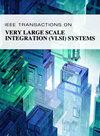具有量化间隔优化ADC和输入位级稀疏优化p20 - dac的8-b MAC操作的电荷域SRAM内存计算宏
IF 2.8
2区 工程技术
Q2 COMPUTER SCIENCE, HARDWARE & ARCHITECTURE
IEEE Transactions on Very Large Scale Integration (VLSI) Systems
Pub Date : 2024-12-05
DOI:10.1109/TVLSI.2024.3509432
引用次数: 0
摘要
内存计算(CIM)由于能够实现深度卷积神经网络(DCNNs)的高能效和高吞吐量,近年来受到了广泛关注。在本文中,我们提出了一个静态随机存取存储器(SRAM) CIM宏,旨在提高边缘设备在执行8-b乘法累加(MAC)操作时的能效。该架构实现了以下内容:1)基于权重翻转存储(WFS)编码方案的逐次逼近寄存器模拟-数字转换器(SAR ADC)读出电路,其中通过优化量化间隔来提高能效;2)使用输入位级稀疏性来降低功耗的与输入相关的部分断电数模转换器(p20 - dac);3)将输入数据加载到CIM阵列时,用于交错MAC计算和读出操作以最小化冗余的管道结构。我们提出的CIM宏是在台积电40纳米CMOS技术中实现的。布局后仿真结果表明,在不考虑输入和权值稀疏性的情况下,平均宏观能量效率为16.8 TOPS/W。本文章由计算机程序翻译,如有差异,请以英文原文为准。
A Charge Domain SRAM Computing-in-Memory Macro With Quantized Interval-Optimized ADC and Input Bit-Level Sparsity-Optimized P2O-DAC for 8-b MAC Operation
Computing-in-memory (CIM) has recently gained significant attention as it achieves high energy efficiency and throughput for deep convolutional neural networks (DCNNs). In this brief, we present a static random access memory (SRAM) CIM macro aimed at improving the energy efficiency of edge devices when performing 8-b multiply-and-accumulate (MAC) operations. The proposed architecture implements the following: 1) a successive approximation register analog-to-digital converter (SAR ADC) readout circuit based on a weight-flip-store (WFS) coding scheme, where energy efficiency is improved by optimizing the quantized interval; 2) an input-relevant partial power-off digital-to-analog converter (P2O-DAC) using input bit-level sparsity to reduce power consumption; and 3) a pipeline structure for interleaving MAC computation and readout operation to minimize the redundancy when loading input data into the CIM array. Our proposed CIM macro is implemented in TSMC 40-nm CMOS technology. Postlayout simulation results show an average macro energy efficiency of 16.8 TOPS/W without input and weight value sparsity.
求助全文
通过发布文献求助,成功后即可免费获取论文全文。
去求助
来源期刊
CiteScore
6.40
自引率
7.10%
发文量
187
审稿时长
3.6 months
期刊介绍:
The IEEE Transactions on VLSI Systems is published as a monthly journal under the co-sponsorship of the IEEE Circuits and Systems Society, the IEEE Computer Society, and the IEEE Solid-State Circuits Society.
Design and realization of microelectronic systems using VLSI/ULSI technologies require close collaboration among scientists and engineers in the fields of systems architecture, logic and circuit design, chips and wafer fabrication, packaging, testing and systems applications. Generation of specifications, design and verification must be performed at all abstraction levels, including the system, register-transfer, logic, circuit, transistor and process levels.
To address this critical area through a common forum, the IEEE Transactions on VLSI Systems have been founded. The editorial board, consisting of international experts, invites original papers which emphasize and merit the novel systems integration aspects of microelectronic systems including interactions among systems design and partitioning, logic and memory design, digital and analog circuit design, layout synthesis, CAD tools, chips and wafer fabrication, testing and packaging, and systems level qualification. Thus, the coverage of these Transactions will focus on VLSI/ULSI microelectronic systems integration.

 求助内容:
求助内容: 应助结果提醒方式:
应助结果提醒方式:


